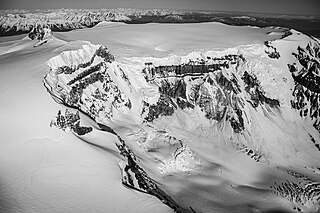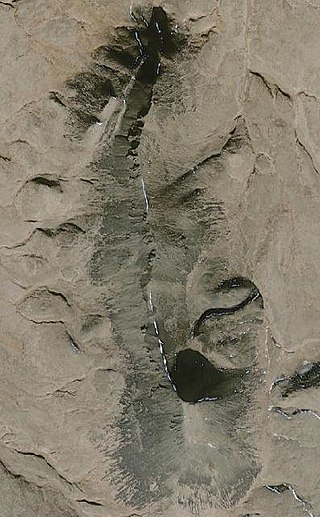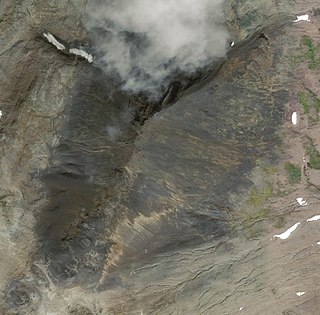
Mount Edziza, sometimes called Edziza Mountain or Edziza Peak, is a stratovolcano in Cassiar Land District of northwestern British Columbia, Canada. It is located on the Big Raven Plateau of the Tahltan Highland which extends along the western side of the Stikine Plateau. The mountain has an elevation of 2,786 metres, making it the highest volcano of the Mount Edziza volcanic complex. However, it had an elevation of at least 3,396 metres before its original summit was likely destroyed by a violent, climactic eruption in the geologic past. Mount Edziza contains several lava domes, cinder cones and lava fields on its flanks, as well as an ice cap that is characterized by several outlet glaciers stretching out to lower altitudes. All sides of the mountain are drained by tributaries of Mess Creek and Kakiddi Creek which are situated within the Stikine River watershed.

The Spectrum Range, formerly called the Spectrum Mountains and the Rainbow Mountains, is a subrange of the Tahltan Highland in the Stikine Country of northwestern British Columbia, 20 km west of the Stewart-Cassiar Highway, south of Mount Edziza and north of the Arctic Lake Plateau. The Spectrum Range falls within Mount Edziza Provincial Park. The range is lightly glaciated, as compared to the other ranges to the west. It is accessible only by foot or via helicopter; there are no roads to the range.

The Interior Mountains or Northern Interior Mountains are the semi-official names for an expansive collection of mountain ranges that comprises much of the northern half of the Canadian province of British Columbia and a large area of southern Yukon.

Tsekone Ridge, also called Tsekone Peak and Black Knight Cone, is an isolated ridge on the Big Raven Plateau of the Tahltan Highland in northwestern British Columbia, Canada. It is located southeast of Telegraph Creek at the north side of Mount Edziza Provincial Park between Eve Cone and Mount Edziza.

Wetalth Ridge is an isolated ridge in northern British Columbia, Canada, located 74 km (46 mi) southwest of Tatogga and south of Telegraph Creek. It lies on the southwest side of Little Arctic Lake at the southwest corner of Mount Edziza Provincial Park.
The Kitsu Plateau is a lava plateau in northern British Columbia, Canada, located east of Mess Lake in Mount Edziza Provincial Park. It is named in association with Kitsu Peak and Kitsu Creek. Kitsu in the Tahltan language is the word for the northern lights.
The Sheep Track Member is a stratigraphic unit of the Big Raven Formation, part of the Mount Edziza volcanic complex in northwestern British Columbia, Canada. It consists of pumice from an explosive eruption that fell over an area about 40 square kilometres. The pumice is of comenditic trachyte composition and reaches a thickness of up to 2 metres along the western edge of Tencho Glacier.

The Mount Edziza volcanic complex is a group of volcanoes and associated lava flows in northwestern British Columbia, Canada. Located on the Tahltan Highland, it is 40 kilometres southeast of Telegraph Creek and 85 kilometres southwest of Dease Lake. The complex encompasses a broad, steep-sided lava plateau that extends over 1,000 square kilometres. Its highest summit is 2,786 metres in elevation, making the MEVC the highest of four large complexes in an extensive north–south trending volcanic region. It is obscured by an ice cap characterized by several outlet glaciers that stretch out to lower altitudes.

The Mess Lake Lava Field is a volcanic field associated with the Mount Edziza volcanic complex of the Northern Cordilleran Volcanic Province in northwestern British Columbia, Canada. It lies northwest of the Spectrum Range on the Kitsu Plateau and consists of young basaltic lava flows and tephra. The source for the basaltic lava and tephra was three cinder cones, including Mess Lake Cone and The Ash Pit, which may be the youngest volcanic feature of the Mount Edziza volcanic complex.

The volcanic history of the Northern Cordilleran Volcanic Province presents a record of volcanic activity in northwestern British Columbia, central Yukon and the U.S. state of easternmost Alaska. The volcanic activity lies in the northern part of the Western Cordillera of the Pacific Northwest region of North America. Extensional cracking of the North American Plate in this part of North America has existed for millions of years. Continuation of this continental rifting has fed scores of volcanoes throughout the Northern Cordilleran Volcanic Province over at least the past 20 million years and occasionally continued into geologically recent times.

Buckley Lake, elevation 841 m (2,759 ft), is a lake in the Tahltan Highland of the Stikine Plateau in northwestern British Columbia, Canada. It is located east of Telegraph Creek at the north end of Mount Edziza Provincial Park. The primary outflow of Buckley Lake is Buckley Creek which flows northeast into the Klastline River.
The Nido Formation is a stratigraphic unit of Neogene age in northwestern British Columbia, Canada.
The Klastline River is a tributary of the Stikine River in northwestern British Columbia, Canada. It flows generally northwest about 70 km (43 mi) to join the Stikine River, which flows southwest across the Canada–United States border into Alaska where it empties into various straits of the Inside Passage. The Klastline River flows through Mount Edziza Provincial Park which lies within the traditional territory of the Tahltan people. Klastline means "confluence" or "junction of waters" in the Tahltan language.

The Big Raven Formation is a stratigraphic unit of Holocene age in northwestern British Columbia, Canada. It is the youngest and least voluminous geological formation of the Mount Edziza volcanic complex (MEVC); it overlies at least six older formations of this volcanic complex. The main volcanic rocks of the Big Raven Formation are alkali basalts and hawaiites, although a small volume of trachyte comprises the Sheep Track Member. These rocks were deposited by volcanic eruptions in the last 12,000 years during the latest magmatic cycle of the MEVC. Alkali basalt and hawaiite are in the form of lava flows and small volcanic cones while trachyte of the Sheep Track Member is mainly in the form of volcanic ejecta which covers an area of about 40 square kilometres.
Tsecha Creek is a tributary of Kakiddi Creek, which in turn is a tributary of the Klastline River, part of the Stikine River watershed in northwest part of the province of British Columbia, Canada. It flows generally west for about 16 km (9.9 mi) to join Kakiddi Creek about 5 km (3.1 mi) south of Kakiddi Creek's confluence with the Klastline River. Tsecha Creek's watershed covers 23.1 km2 (8.9 sq mi) and its mean annual discharge is estimated at 0.423 m3/s (14.9 cu ft/s). The mouth of Tsecha Creek is located about 44 km (27 mi) east-southeast of Telegraph Creek, about 26 km (16 mi) west of Iskut and about 73 km (45 mi) south-southwest of Dease Lake. Tsecha Creek's watershed's land cover is classified as 47.8% barren, 27.5% conifer forest, 13.1% shrubland, 10.3% snow/glacier, and small amounts of other cover.
Ball Creek is a tributary of the Iskut River and part of the Stikine River watershed in northwest part of the province of British Columbia, Canada. From its source in the mountains south of Mount Edziza, near Yeda Peak, it flows generally southeast and east for roughly 41 km (25 mi) to empty into the Iskut River, the largest tributary of the Stikine River.
More Creek is a tributary of the Iskut River and part of the Stikine River watershed in northwest part of the province of British Columbia, Canada. From its source near Yeda Peak in the Spectrum Range south of Mount Edziza, it flows generally south and east for roughly 65 km (40 mi) to empty into the Iskut River, the largest tributary of the Stikine River.
The Mount Edziza volcanic complex (MEVC) in British Columbia, Canada, has a long history of volcanism that spans more than six million years. It occurred during five cycles of magmatic activity which were characterized by 13 periods of eruptive activity. This volcanism has led to the formation of several types of volcanic landforms, including cinder cones, stratovolcanoes, subglacial volcanoes, shield volcanoes, lava domes and lava fields. The 1,000-square-kilometre (390-square-mile) plateau comprising the MEVC owes its origin to successive eruptions of highly mobile lava flows. Volcanic rocks such as alkali basalt, hawaiite, trachybasalt, benmoreite, tristanite, mugearite, trachyte, comendite and pantellerite were deposited by multiple eruptions of the MEVC; the latter eight are products of varying degrees of magmatic differentiation in underground magma reservoirs.

Tencho Glacier is a mountain glacier in northwestern British Columbia, Canada. It is located inside Mount Edziza Provincial Park on the Tahltan Highland, an upland area of the Stikine Plateau. Tencho Glacier is the source of several small streams that flow from the Mount Edziza volcanic complex.

The Edziza Formation is a stratigraphic unit of Pleistocene age in northwestern British Columbia, Canada. First described in 1984, the Edziza Formation was mapped as one of several geological formations of the Mount Edziza volcanic complex. It overlies at least four other geological formations of this volcanic complex that differ in age and composition. The main volcanic rock comprising the Edziza Formation is trachyte which was deposited by volcanic eruptions at the end of the third magmatic cycle of the Mount Edziza volcanic complex 0.9 million years ago.











